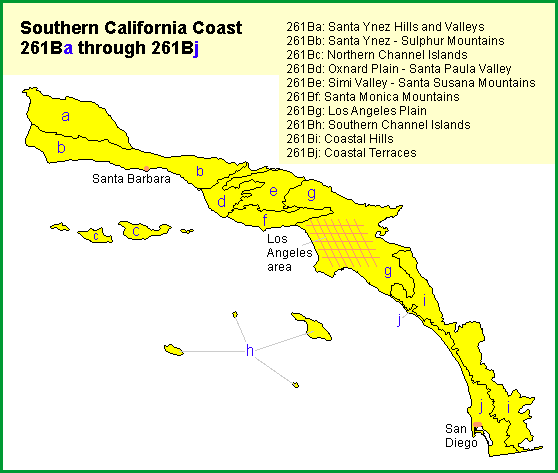 | Southern California Coast |
|
|
Mountains, hills, valleys, and plains of the Transverse Ranges and of the Peninsular Ranges that are close enough to the Pacific Ocean for the climate to be modified greatly by marine influence
Geomorphology. Narrow ranges and broad fault blocks; alluviated lowlands and coastal terraces. Transverse and Peninsular Ranges geomorphic province.
Lithology. Cenozoic marine and nonmarine sedimentary rocks and alluvial deposits.
Soil Taxa. Alfisols, Entisols, Inceptisols, Mollisols, Ultisols and Vertisols in combination with thermic, isothermic or mesic soil temperature regimes and xeric, ustic or aquic soil moisture regimes.
Vegetation. Predominant potential natural communities include the California sagebrush - California buckwheat series, Mixed chaparral shrublands, Coast live oak series, Chamise series, Valley oak series and mixed sage series.
The following series are found throughout the section and are not restricted to or extensive in any subsection. Series dominated by exotic plants are not listed under subsections unless they are extensive and stable.
Series dominated by exotic plants: Broom series, California annual grassland series, Eucalyptus series, Giant reed series, Iceplant series, Introduced perennial grassland series, Kentucky bluegrass series, Pampas grass series and Tamarisk series.
Series that can occur in all subsections, but are not extensive: Alkali sacaton series, Bulrush series, Bulrush - cattail series, Cattail series, Creeping ryegrass series, Duckweed series, Foothill needlegrass series, Mexican elderberry series, Mosquito fern series, Nodding needlegrass series, One-sided bluegrass series, Pondweeds with floating leaves series, Pondweeds with submerged leaves series, Purple needlegrass series. Saltgrass series, Seep weed series, Sedge series and Spikerush series.
Series restricted to riparian settings: Arroyo willow series, Black willow series, California sycamore series, Fremont cottonwood series, Mixed willow series, Mulefat series, Narrowleaf willow series, Pacific willow series, Red willow series and White alder series.
Fauna. Mammals include mule deer, coyotes, bobcat, fox, skunk, raccoon, opossum and ground squirrel. Turkey vultures, hawks, jays, quail, owls, herons, egrets, flycatchers, swallows and ravens are common birds. Birds of concern include the brown pelican, lesser tern, osprey, black rail, clapper rail, California gnatcatcher and savannah sparrow. Reptiles and amphibians include the western rattlesnake, common garter snake, alligator lizards and several species of salamanders and frogs. Marine and shore species include sea lions, seals, brown pelicans, gulls, cormorants, terns and various shore birds.
Elevation. Sea level to 3,000 feet.
Precipitation. 10 to 30 inches.
Temperature. 45░ to 65░F. Summer daytime temperatures often modified by morning fog and sea breezes.
Growing Season. 250 to 365 days.
Surface Water Characteristics. Very few perennial streams occur in the area. Perennial and intermittent streams occur in alluvial and weak bedrock channels that flow directly to the Pacific Ocean. High velocity and quantity flows periodically occur in the numerous intermittent drainages.
Disturbance Regimes.
Fire: Historic occurrence has changed from fires of variable frequency, season and intensity to more frequent, larger and more intense fires.
Seismic Activity: Seismically active area with strong shaking and ground rupture.
Air Quality: Some plant and animal species are noticeably affected by air pollution.
Land Use. Composition and successional sequence of some communities (especially grassland communities) has changed because of plant and animal species introduced between the late 1700Æs and early 1900Æs related to grazing, agriculture, and urbanization. Most of the area is densely urbanized.
Cultural Ecology. Humans have been utilizing the area for some 8,000 to 10,000 years, and have been an integral part of south coast ecology for 2,000 to 3,000 years, thriving on the diversity of habitats from ocean and estuary to hills and scrublands, and intensively gathering numerous resources. The Spanish first explored the coastal areas in the mid-1500Æs, however, did not establish permanent settlements until the Mission Period, in the late 1700Æs, thus introducing agriculture and religious and social changes. Widespread urbanization of the Los Angeles basin began in the late 1800Æs. Contemporary attitudes and beliefs are varied; lifestyle is urban. The international border and large Hispanic populations contribute to cultural diversity. The economy is varied and urban oriented; shipping, fishing, tourism and recreation are important industries.
Subsections. The Southern California Coast section is divided into 10 subsections.

